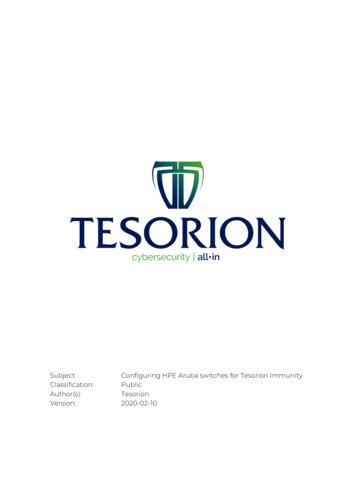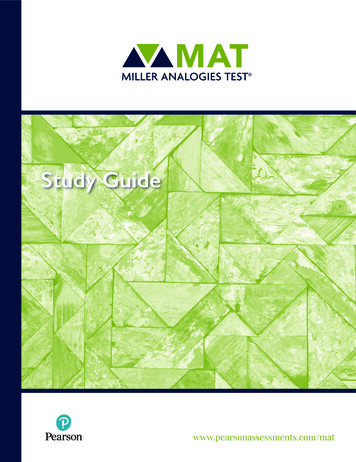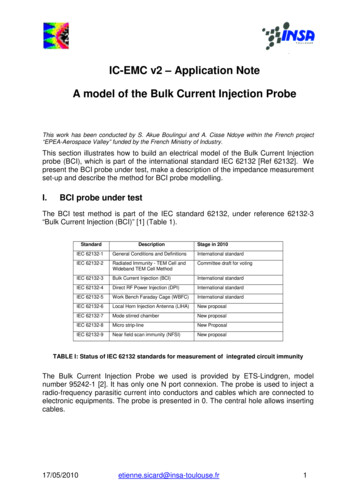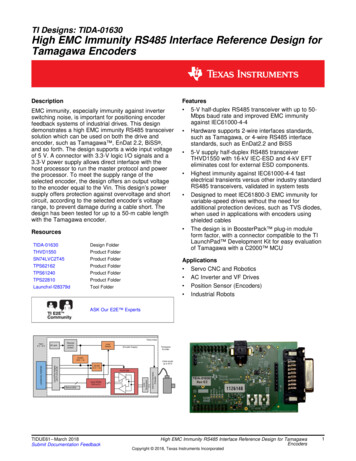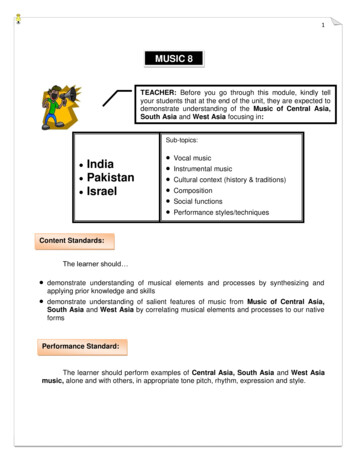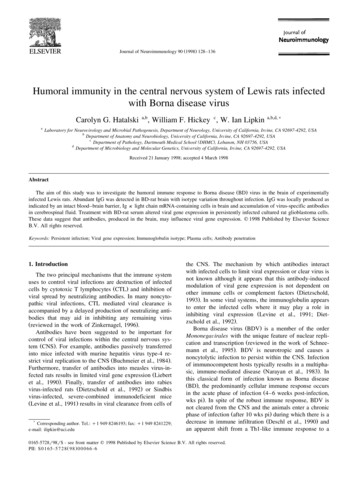
Transcription
Journal of Neuroimmunology 90 Ž1998. 128–136Humoral immunity in the central nervous system of Lewis rats infectedwith Borna disease virusCarolyn G. Hatalskiaa,b, William F. Hickey c , W. Ian Lipkina,b,d,)Laboratory for NeuroÕirology and Microbial Pathogenesis, Department of Neurology, UniÕersity of California, IrÕine, CA 92697-4292, USAbDepartment of Anatomy and Neurobiology, UniÕersity of California, IrÕine, CA 92697-4292, USAcDepartment of Pathology, Dartmouth Medical School (DHMC), Lebanon, NH 03756, USAdDepartment of Microbiology and Molecular Genetics, UniÕersity of California, IrÕine, CA 92697-4292, USAReceived 21 January 1998; accepted 4 March 1998AbstractThe aim of this study was to investigate the humoral immune response to Borna disease ŽBD. virus in the brain of experimentallyinfected Lewis rats. Abundant IgG was detected in BD-rat brain with isotype variation throughout infection. IgG was locally produced asindicated by an intact blood–brain barrier, Ig k light chain mRNA-containing cells in brain and accumulation of virus-specific antibodiesin cerebrospinal fluid. Treatment with BD-rat serum altered viral gene expression in persistently infected cultured rat glioblastoma cells.These data suggest that antibodies, produced in the brain, may influence viral gene expression. q 1998 Published by Elsevier ScienceB.V. All rights reserved.Keywords: Persistent infection; Viral gene expression; Immunoglobulin isotype; Plasma cells; Antibody penetration1. IntroductionThe two principal mechanisms that the immune systemuses to control viral infections are destruction of infectedcells by cytotoxic T lymphocytes ŽCTL. and inhibition ofviral spread by neutralizing antibodies. In many noncytopathic viral infections, CTL mediated viral clearance isaccompanied by a delayed production of neutralizing antibodies that may aid in inhibiting any remaining virusŽreviewed in the work of Zinkernagel, 1996.Antibodies have been suggested to be important forcontrol of viral infections within the central nervous system ŽCNS. For example, antibodies passively transferredinto mice infected with murine hepatitis virus type-4 restrict viral replication to the CNS ŽBuchmeier et al., 1984.Furthermore, transfer of antibodies into measles virus-infected rats results in limited viral gene expression ŽLiebertet al., 1990. Finally, transfer of antibodies into rabiesvirus-infected rats ŽDietzschold et al., 1992. or Sindbisvirus-infected, severe-combined immunodeficient miceŽLevine et al., 1991. results in viral clearance from cells of)Corresponding author. Tel.: q1 949 8246193; fax: q1 949 8241229;e-mail: ilipkin@uci.eduthe CNS. The mechanism by which antibodies interactwith infected cells to limit viral expression or clear virus isnot known although it appears that this antibody-inducedmodulation of viral gene expression is not dependent onother immune cells or complement factors ŽDietzschold,1993. In some viral systems, the immunoglobulin appearsto enter the infected cells where it may play a role ininhibiting viral expression ŽLevine et al., 1991; Dietzschold et al., 1992.Borna disease virus ŽBDV. is a member of the orderMononegaÕirales with the unique feature of nuclear replication and transcription Žreviewed in the work of Schneemann et al., 1995. BDV is neurotropic and causes anoncytolytic infection to persist within the CNS. Infectionof immunocompetent hosts typically results in a multiphasic, immune-mediated disease ŽNarayan et al., 1983. Inthis classical form of infection known as Borna diseaseŽBD., the predominantly cellular immune response occursin the acute phase of infection Ž4–6 weeks post-infection,wks pi. In spite of the robust immune response, BDV isnot cleared from the CNS and the animals enter a chronicphase of infection Žafter 10 wks pi. during which there is adecrease in immune infiltration ŽDeschl et al., 1990. andan apparent shift from a Th1-like immune response to a0165-5728r98r - see front matter q 1998 Published by Elsevier Science B.V. All rights reserved.PII: S 0 1 6 5 - 5 7 2 8 Ž 9 8 . 0 0 0 6 6 - 6
C.G. Hatalski et al.r Journal of Neuroimmunology 90 (1998) 128–136Th2-like immune response within the CNS ŽHatalski et al.,1998. Žnext paper.The role of antibodies in the course of BDV infection isnot well understood. High titer antibodies against BDVproteins and antibodies with neutralization activity havebeen identified in BD-rat serum from animals in thechronic phase of infection ŽDanner et al., 1978; Ludwig etal., 1988; Briese et al., 1995; Hatalski et al., 1995. Thereis evidence that antibodies to BDV are present in thecerebrospinal fluid ŽCSF. of infected animals ŽLudwig etal., 1977; Ludwig and Thein, 1977.; however, neither thespecificities of these antibodies nor their role in regulatingvirus replication or dissemination are known.Here we show the presence of BDV-specific antibodiesin infected rat brain and provide evidence that these antibodies are produced within the brain rather than enteringthe CNS via a permeable blood–brain barrier ŽBBB.Although these BDV-specific antibodies do not appear toclear the virus, they may be associated with modulation ofBDV gene expression in the CNS.2. Materials and methods2.1. BDV infected animalsFour-to-six week old Lewis rats were infected intracranially or intranasally with approximately 5 10 4 focusforming units of BDV strain Her80-1 ŽCarbone et al.,1987; Schneider et al., 1994. Rats were sacrificed at129various timepoints throughout infection including 3.5 wkspi Žpre-disease., 4-6 wks pi Žacute phase. and 15 wks to 1year post-infection Žchronic phase. Ten-to-twelve weekold noninfected Lewis rats were used as controls. At thetime of sacrifice, rats were either perfused with calcium–magnesium-free phosphate-buffered saline followed by 4%buffered paraformaldehyde or terminally anesthetized forcollection of CSF, serum and brain samples.2.2. Collection of CSF and serumRats were sacrificed in the chronic stage of disease, 3–6months post-infection. At time of sacrifice, rats were terminally anesthetized with methoxyflurane ŽMetofane, Pitman-Moore. and CSF was withdrawn by ventricular puncture of the fourth ventricle with a 22-gauge needle. Thequality of CSF Žabsence of serum contaminants. was determined by presence of erythrocytes in the CSF. Sampleswhich contained erythrocytes were excluded from evaluation.2.3. Immunohistochemistry of BD-rat brains stained usinganti-IgG and anti-albumin antibodiesImmunohistochemistry was performed using anti-IgGantibodies as previously described ŽHickey et al., 1983.Briefly, slide-mounted sections were blocked and incubated with biotinylated goat anti-rat IgG antibodies. Afterwashing and inhibiting endogenous peroxidase activity, thesections were incubated sequentially with avidin-per-Fig. 1. Western immunoblot analysis of immunoglobulin in BD rat brain homogenates. Rat brain homogenates Ž20 m g. were size-fractionated bySDS-PAGE Ž8% gel. under nonreducing conditions and transferred to nitrocellulose membranes. The membranes were bound with goat anti-rat IgG ŽpanelA. or IgM Žpanel B. antibodies conjugated with horseradish peroxidase and visualized using a chemiluminescent substrate. Samples included: positivecontrol of 0.3 m l of NI rat serum Žlane 1.; noninfected rat brain Žlane 2.; acute rat brains, 4–5 wks pi Žlanes 3–5.; and chronic rat brains, 15 wks pi Žlanes6–8.
130C.G. Hatalski et al.r Journal of Neuroimmunology 90 (1998) 128–136oxidase conjugate ŽVector Labs. and 3,3-diaminobenzidine. Immunohistochemistry for detection of albumin inbrain sections was performed using rabbit anti-human albumin antibodies ŽAmerican Qualex. diluted 1:100 followed by goat anti-rabbit IgG conjugated with horseradishperoxidase ŽSigma. Prior to these experiments, the rabbitanti-human albumin antibodies were shown to cross-reactwith rat serum albumin by SDS-PAGE immunoblot ŽWestern blot. and enzyme-linked immunosorbent assayŽELISA.2.4. Western blot of brain homogenate for detection of IgGTwenty m g of each BD-rat brain homogenate Ž20%wt.rvol. in phosphate buffered saline. were sizefractionated by SDS-PAGE Ž8% gel. ŽLaemmli and Favre,1973. under nonreducing conditions and transferred tonitrocellulose membranes ŽSchleicher and Schuell. ŽTowbinet al., 1979. The membrane was bound according to themethod described previously ŽHatalski et al., 1995. withgoat anti-rat IgG ŽSigma. or goat anti-rat IgM ŽSigma.antibodies Ždiluted 1:300 and 1:100, respectively. conjugated with horseradish peroxidase and visualized usingLumiglo chemiluminescent substrate ŽKirkegaard and PerryLaboratories.2.5. Determination of relatiÕe amounts of antibodies, albumin and neutralization actiÕity in CSF and seraA modified ELISA was performed to determine therelative amounts of IgG, IgM and albumin in the heat-inactivated CSF and sera. Multi-well plates were coatedovernight at 378C with serial dilutions Ž0.2 m l to 1 10y4m l per well. of sera or CSF in borate buffer Ž100 mMboric acid, 50 mM sodium borate and 75 mM sodiumchloride, pH 8.4. After washing thrice with wash bufferŽ0.05% Tween-20 in phosphate buffered saline., the wellswere blocked for 1 h at 378C using 0.01% nonfat dry milkin wash buffer. Antibodies were bound for 2 h at 378C.The antibodies used were anti-rat IgG Žwhole molecule,Sigma., anti-rat IgM Ž m heavy chain, Sigma. and anti-human albumin ŽAmerican Qualex.; all antibodies were conjugated with horseradish peroxidase and diluted 1:1000 inwash buffer containing 0.01% nonfat dry milk. After washing five times, the plates were developed using 3,3Y ,5,5Ytetramethylbenzidine. The CSF and serum titers were determined for each animal as the endpoint dilutions thatyielded an equal optical density at 450 nm within a linearoptical density range Ž0.1–0.4.ELISA was performed as previously described ŽBrieseet al., 1995. for detection of IgGs in CSF and serumFig. 2. Immunohistochemical analysis of IgG in BD-rat brains. BD-rat brain sections from rats at different times post infection were bound with anti-ratIgG antibodies conjugated with horseradish peroxidase and stained with 3,3-diaminobenzidine. Representative fields from parietal cortex are shown fornoninfected rat ŽA., or BD-rats from 3.5 wks pi ŽB., 5 wks pi ŽC., 15 wks pi ŽD.
C.G. Hatalski et al.r Journal of Neuroimmunology 90 (1998) 128–136samples that bound to BDV proteins ŽN, P or gp18.Serum and CSF titers were measured simultaneously forindividual animals. Neutralization assays were performedas previously described ŽHatalski et al., 1995. Briefly,serially-diluted sera or CSF were incubated with virusprior to inoculation of susceptible cells. The neutralizationtiter for each CSF and serum sample was defined as thereciprocal dilution that inhibited viral infectivity by 50%.2.6. Detection of Ig k light chain mRNANorthern blot hybridization and nonradioactive in situhybridization analysis were performed as described previously ŽLipkin et al., 1990. Probes were generated fromplasmids containing fragments of Ig k light chain and IgGheavy chain cDNAs ŽSchwemmle and Lipkin, unpublisheddata.2.7. Isotype of serum and brain immunoglobulinRadial immunodiffusion ŽRID. assays were performedusing Bind-a-RID rat isotyping kits ŽThe Binding Site. toquantitate levels of IgA, IgM, IgG, IgG1, IgG2a, IgG2band IgG2c in sera from rats at different stages of BD. Inaddition, brain homogenates from rats at different stages of131disease were used to isolate all immunoglobulins using theT-gel purification kit ŽPierce. Following purification, samples were concentrated using Centricon columns ŽAmicon.and assayed for IgG subclass in the Bind-a-RID isotypingsystem.2.8. Anti-sera treatment in Õitro and analysis of Õiral geneexpressionC6BDV cells Žpersistently-infected rat glioblastomacells, Carbone et al., 1993. were treated every 6 h for 48 hwith medium containing either pooled, heat-inactivated,noninfected rat sera ŽNIsera. diluted 1:100 or pooled,heat-inactivated sera from chronically-infected ratsŽBDsera. diluted 1:100. To determine if activity was removed by treatment with protein-A, each pooled serumwas diluted 1:33 in PBS and bound with 0.2 g of proteinA–Sepharose ŽSigma. overnight at 48C. This mix wasfurther diluted with concentrated culture medium to 1:100and used to treat cells. Rabbit anti-N, rabbit anti-P and ratanti-nonglycosylated gp18 monospecific sera were eachalso used for treatment at 1:50 dilution. After treatment,the cells were harvested and RNA was extracted ŽChomczynski and Sacchi, 1987. Northern hybridization analysiswas performed using double-stranded, w32 Px-labeled DNAFig. 3. Northern blot hybridization analysis of Ig k light chain mRNA in BD rat brain samples. A total of 10 m g of total cell RNA from brains ofnoninfected rats Žlane 1., or BD-rats 4 wks pi Žlanes 2–3., 5 wks pi Žlanes 4–5. and 15 wks pi Žlanes 6–9. were hybridized with a double-stranded cDNAprobe for rat Ig k light chain mRNA. Blots were stripped and rehybridized with a probe for rat cyclophilin mRNA to control for RNA quantity andintegrity.
132C.G. Hatalski et al.r Journal of Neuroimmunology 90 (1998) 128–136probes to fragments of the BDV N and P ORFs ŽLipkin etal., 1990. These probes hybridize to both viral genomicRNA and viral subgenomic mRNAs.tion of IgG was most intense in gray matter regions and,consistent with findings of Deschl et al. Ž1990., appearedto be predominantly intercellular or on the cell surface.3.2. Analysis of BBB integrity3. Results3.1. Analysis of BD-rat brains for the presence of immunoglobulinWestern immunoblot analysis of brain homogenateswas performed for detection of IgGs in BD-rat brains andto compare the relative abundance of this signal in brainsamples from different times post-infection. Immunoblotswere bound with antibodies to detect IgG or IgM. Although IgG was detected in normal rat brain samples, therewas a marked increase in IgG signal from 4–5 to 15 wkspi ŽFig. 1A. There was no apparent difference betweenbrain IgM levels in normal rats and BD-rats at 4–5 wks pi;however, there was a slight increase in IgM in brainhomogenates from BD-rats at 15 wks pi ŽFig. 1B.To determine the distribution of immunoglobulin inBD-rat brains, immunohistochemical analyses were performed using anti-rat IgG antibodies on rat brain sectionsfrom different times post-infection. No staining was detected in normal rat brain ŽFig. 2A. At 3.5 wks pi, faintsignal was detected around blood vessels ŽFig. 2B. By5–6 wks pi, there was heterogeneous signal for IgG inmany gray matter regions Žincluding cerebral cortex, thalamus, basal ganglia; Fig. 2C. In the chronic phase ofdisease Žafter 10 wks pi. all rats showed intense stainingfor IgG throughout the brain ŽFig. 2D. This stainingpattern was observed as late as 1 year post-infection, thelatest timepoint examined Ždata not shown. The concentra-To determine whether the immunoglobulin detected inthe CNS was due to leakage of the BBB, analysis of BBBintegrity was performed by measuring the amount of albumin in the CSF and the serum. The ratio of albumin in theCSF relative to the serum was determined for 11 chronically-infected BD-rats and four noninfected controls. Therewas no significant difference in the CSF to serum ratio ofalbumin between the infected and noninfected rats Ž3.42 "0.78 vs. 2.65 " 0.37, respectively., indicating that the BBBin the chronically infected animals was similar in integrityto that of the noninfected animals. Furthermore, in all rats,consistent with previous reports for normal rats ŽWestergren and Johansson, 1991., the CSF to serum ratio foralbumin was less than 5. This analysis was only performedfor rats in the chronic phase of infection, when immuneinfiltration had diminished. To assess BBB integrity inacute infection, thin sections of rat brain from differenttimes post infection were stained using anti-albumin antibodies as a secondary measure for permeability. Consistentwith previous results ŽDeschl et al., 1990., no albuminimmunoreactivity was detected in the brain parenchymaŽdata not shown.3.3. Analysis of BD-rat brains for the presence of IgmRNATo determine the timecourse and sites for synthesis ofIgG in the BD-rat brain we performed Northern blotFig. 4. Detection of cells containing Ig k light chain mRNA. Nonradioactive in situ hybridization was performed using a digoxygenin-labeled RNA probecomplementary to a fragment of the Ig k light chain mRNA. Following hybridization, tissue was bound with anti-digoxygenin alkaline phosphataseconjugated antibody and developed using NBTrBCIP substrate. Photomicrographs of piriform cortex taken at 25 magnification are shown for ŽA.noninfected rat brain, ŽB. BD-rat brain at 5 wks pi, and ŽC. BD-rat brain at 15 wks pi.
C.G. Hatalski et al.r Journal of Neuroimmunology 90 (1998) 128–136133Table 1Mean CSF to serum antibody ratioNonspecific IgMNoninfectedChronic BD-rat0.00286 " 0.0013130.00531 " 0.00115Nonspecific IgG0.00276 " 0.001420.00531 " 0.00115BDVNPgp18Neutralizingn.d.0.07 " 0.013n.d.0.1611 " 0.0524n.d.0.0667 " 0.0176n.d.0.0996 " 0.0221Antibody CSF to serum ratio is defined as the antibody titer from the CSF sample divided by the antibody titer from the serum sample from the sameanimal. The mean of at least four animals per group.n.d.s Not detectable.hybridization and in situ hybridization for detection of IgmRNA. Northern blot hybridization analyses were performed on BD-rat brain samples from the acute and chronicphases of infection using a probe to detect Ig k light chainmRNA ŽFig. 3. No Ig k light chain mRNA was detectedin brains of noninfected rats or rats at 4 wks pi. At 5 wkspi, Ig k light chain mRNA was present at low levels witha marked increase by 15 wks pi. Northern blot hybridization analysis using a probe to detect IgG heavy chainmRNA gave similar results Ždata not shown.Nonradioactive in situ hybridization analysis was performed to identify the cells in the BD-rat brain that expressIg k light chain mRNA. In noninfected rat brain, rarelabeled cells were detected in the meninges, but not in thebrain parenchyma ŽFig. 4A. In contrast, labeled cells withmorphology consistent with plasma cells were detected inthe meninges, perivascular infiltrates and brain parenchymaat 5 wks pi ŽFig. 4B. The abundance of labeled cellsincreased at 6–7 wks pi, and remained at high levelsthrough 15 wks pi ŽFig. 4C. Although labeled cells weredetected in most gray matter regions of the brain, thesecells were most abundant in the areas of the olfactorytubercle, piriform cortex and amygdala in both the acuteand the chronic phases of infection.3.4. Production of BDV-specific antibodies in the CNSPrevious results suggest that BDV-specific antibodiesare present in the CSF of naturally and experimentally-infected animals ŽLudwig et al., 1977; Ludwig and Thein,1977. CSF and sera were analyzed for BDV immunoreactivity to determine if the antibodies produced withinthe CNS were specific for viral antigens. The ratio ofantibodies in the CSF relative to the serum was determinedfor nonspecific IgG and IgM, the BDV N, P and gp18proteins, and the virus neutralization activity ŽTable 1.The CSF to serum ratios for antibodies to BDV proteinsand neutralization activity were at least five-fold greaterthan for nonspecific IgG or IgM indicating that BDVspecific antibodies are produced in the CNS.3.5. Characterization of immunoglobulin isotypesThe isotypes of total serum immunoglobulins weredetermined for rats in the acute Ž5 wks pi. and chronic Ž15wks pi. phases of infection by RID ŽTable 2. Acuteinfection with BDV resulted in increased levels of serumIgA, IgM, IgG2b and IgG2c. Transition to the chronicphase of disease was associated with a reduction in IgA,and elevations of IgM, IgG Žin particular IgG2a and IgG2bsubtypes.; IgG2c remained constant throughout the courseof the disease.The profiles of IgG isotypes isolated from the CNSdiffered from those in sera. CNS levels of IgG, IgG1,IgG2b and IgG2c were each elevated in the acute phase ofinfection and continued to increase into the chronic phaseof infection ŽTable 3. In contrast, IgG2a in the CNS waselevated in the acute phase but declined in the chronicphase of infection.3.6. Antibody-mediated alteration in BDV gene expressionIn order to determine whether the presence of anti-BDVantibodies might influence production of viral gene products, persistently-infected C6BDV cells were treated withpooled sera from chronically-infected rats Ž3–6 mo pi,BDsera. and analyzed for the presence of viral nucleicTable 2Comparison of antibody isotypes in sera from rats at different times post-infectionRat seraIgAIgMIgGIgG1IgG2aIgG2bIgG2cNoninfectedAcute Ž5 wks pi.Chronic Ž15 wks pi.34124 " 469"02241284 " 941804 " 47766010,186 " 234317,000 " 2368931931 " 301846 " 015351550 " 4542443 " 47314152833 " 5385423 " 732137476 " 37478 " 61Mean antibody isotype Žmgrl. in serum" standard error of the mean Ž n s 3 for each acute and chronic groups.Noninfected values from a single animal are consistent with published reports ŽKinoshita and Ross, 1993.
C.G. Hatalski et al.r Journal of Neuroimmunology 90 (1998) 128–136134Table 3Comparison of antibody isotypes in brain from rats at different timespost-infectionRat brain sampleIgGIgG1IgG2aIgG2bIgG2cNoninfectedAcute Ž5 wks 20n.d.1.31.34.392.57Chronic Ž15 wks pi.Data presented as m g antibody isotype per gram of brain Ždata shown forns1 noninfected and ns 2 each acute and chronic.n.d.s Not detectable.acids. For comparison, C6BDV cells were also treatedwith pooled sera from noninfected rats ŽNIsera. or serathat had been incubated with protein A–Sepharose toremove IgG. Following treatment of cells, RNA was extracted and analyzed by Northern hybridization for thepresence of BDV genomic and anti-genomic RNAs Ž8.9kb. and two subgenomic viral transcripts Ž0.8 and 1.2 kb.Levels of BDV RNAs were lower in C6BDV cells treatedwith BDsera than in parallel cultures treated with NIseraŽFig. 5. RNA levels were reduced 27%, 53% and 47% forthe 8.9 kb, 1.2 kb and 0.8 kb RNAs, respectively. Incubation of BDsera with protein-A prior to its application toC6BDV cells abrogated these effects. Treatment of C6BDVcells with monospecific sera directed against N, P orFig. 5. BD-rat anti-sera modulate viral gene expression in vitro. Northernhybridization analysis of viral nucleic acid from persistently-infected C6ŽC6BDV. cells treated with pooled noninfected rat sera Žlanes 1 and 2. orpooled chronic BD-rat sera Žlanes 3 and 4. To determine if immunoglobulin or another serum component was responsible for this effect, serawere pretreated with protein-A Sepharose to remove IgG prior to additionto cells Žlanes 2 and 4. Blots were hybridized with double-stranded,w32 Px-labeled DNA probes to fragments of the BDV N and P ORFs todetect the 1.2 and 0.8 kb RNAs, respectively as well as the 8.9 kb RNA.nonglycosylated gp18 did not alter level of BDV RNAsŽdata not shown.4. DiscussionIn the Lewis rat model system of BDV infection, thechronic phase of disease is associated with high titer serumantibodies to BDV proteins including antibodies with neutralizing activity ŽHatalski et al., 1995. The experimentsdescribed here were performed to determine Ži. the timecourse and distribution of antibodies to BDV in brains ofBD-rats, Žii. whether the source of these antibodies is localsynthesis or transport into the CNS from the periphery, andŽiii. the potential effects of these antibodies on viral geneexpression.Abundant IgG was found in the brain homogenates ofchronically-infected rats. Localization of this IgG in thebrain showed intense staining throughout the gray matterand was not confined to perivascular regions. Two lines ofevidence indicate that this IgG was produced in the CNSrather than in the periphery. First, the BBB appears to beintact in BD. Albumin immunohistochemistry and CSF toserum ratios were similar in infected and noninfected rats.These results confirm and extend studies of other investigators who found evidence for BBB integrity throughalbumin histochemistry ŽDeschl et al., 1990. and Evan’sblue dye perfusion studies ŽLudwig and Thein, 1977.Second, in situ hybridization confirmed the presence ofplasma cells in the BD-rat brain parenchyma.Analysis of antibodies found in the CNS revealed specificity for BDV. Comparison of the titers of antibodies inCSF and sera for binding to BDV proteins and neutralization activity suggests that BDV-specific antibodies areconcentrated in the CNS relative to nonspecific IgG ŽTable1. Titers were highest to P protein although antibodieswith neutralization activity were also prominent. No directdata were uncovered to indicate the target antigens forparenchymal brain IgG; however, the high concentration ofBDV-specific antibodies in the CSF suggests thatparenchymal IgG are directed against viral proteins.Serum isotype analysis showed an increase in all isotypes from the acute to the chronic phase of infectionŽTable 2. This result is consistent with elevated levels ofBDV-specific antibodies throughout the course of BDŽBriese et al., 1995. Analysis of immunoglobulin isotypesin the CNS also revealed that most CNS immunoglobulinlevels increased between the acute and chronic phases ofinfection. This increase was coincident with increasednumbers of Ig k mRNA-containing cells Žplasma cells. inbrain during the chronic phase of infection ŽFig. 4. IgG2awas the only isotype that was detected at lower levels inthe CNS in the chronic phase of infection ŽTable 3. Thisfinding is consistent with a shift from a Th1-like immuneresponse Žacute phase. followed by a Th2-like immune
C.G. Hatalski et al.r Journal of Neuroimmunology 90 (1998) 128–136response Žchronic phase., a phenomenon that may facilitatereduction of immunopathology in the face of persistentCNS infection ŽHatalski et al., 1998. This alteration in theimmune response may be specific for the CNS as serumIgG2a levels are elevated in the chronic phase of infectionŽTable 2.The presence of BDV-specific antibodies in the CNSsuggests that antibody-mediated mechanisms may contribute to cell death in the BD-rat brain. Effector cells inantibody-dependent cell-mediated cytotoxicity ŽADCC.,such as NK cells, macrophages and activated microglia,are present in the brains of BD-rats ŽDeschl et al., 1990.Žunpublished observations. Dietzschold et al. Ž1995. haveshown that complement system components are present inBD rat brain. The antibody isotypes IgG2a and IgG2bparticipate ADCC and complement mediated lysis. Thus, itis conceivable that antibody-mediated mechanisms of celllysis such as ADCC and complement-mediated lysis contribute to the neuropathology associated with BD.In vitro studies presented here suggest the potential ofvirus-specific antibodies in the CNS to modulate viral geneexpression. BDV genomic and subgenomic RNA levels inC6BDV cells were reduced following treatment with BDrat sera ŽFig. 5. The reduction was more marked for viraltranscripts Ž0.8 and 1.2 kb RNAs. than the genomic andanti-genomic RNAs Ž8.9 kb. suggesting that, for this treatment paradigm, the antibodies may modulate abundance ofviral gene products. We were unable to discern the specificities of the antibodies responsible for altered BDV geneexpression. Experiments to define the target antigenŽs.responsible using monospecific sera were unsuccessful.Rabbit monospecific anti-sera to N or P did not alter viralgene expression; it was unclear whether this reflects aspecies difference, or implies that antibodies to N and Pare not responsible for the effect. In other systems, antibodies to viral glycoproteins are often responsible forclearance or altered gene expression ŽSchneider-Schaulieset al., 1992; Dietzschold, 1993. The antiserum to gp18that was used for this assay was generated against nonglycosylated, recombinant protein. Thus, it is difficult toassess its failure to modulate levels of BDV RNAs. Definition of the epitopes and mechanisms responsible for antibody-induced modulation of BDV gene expression in vitrowill require studies with antibodies to native gp18 as wellas the G, pol and X proteins of BDV.The in vivo significance of the humoral immune response to BDV for control of viral gene expression andpathogenesis remains to be determined. Furthermore, thereis a modest decrease in viral gene expression in thechronic phase of infection relative to the acute phaseŽHatalski and Lipkin, unpublished observations., which isnot inconsistent with the time course for the appearance inthe CNS of high levels of antibodies specific for BDV.However, it is not clear if these changes are important forcontrolling the virus, influencing host cell survival oraffecting other aspects of the immune response. Nonethe-135less, the concentration of IgG within the CNS of chronically-infected rats suggests that the humoral immune response is likely to influence pathogenesis and may play arole in modulation of viral gene expression.AcknowledgementsWe would like to thank Dr. Martin Schwemmle forimmunoglobulin probes and Dr. Benedikt Weissbrich andAnn Lewis for their helpful comments. This work wassupported in part by NS-29425 ŽCGH and WIL. andNS-27321 ŽWFH.ReferencesBriese, T., Hatalski, C.G., Kliche, S., Park, Y.S., Lipkin, W.I., 1995.Enzyme-linked immunosorbent assay for detecting antibodies to Bornadisease virus-specific proteins. J. Clin. Microbiol. 33, 348–351.Buchmeier, M.J., Lewicki, H.A., Talbot, P.J., Knobler, R.L., 1984.Murine hepatitis virus-4 Žstrain JHM.-induced neurologic disease ismodulated in vivo by monoclonal antibody. Virology 132, 261–270.Carbone, K.M., Duchala, C.S., Griffin, J.W., Kincaid, A.L., Narayan, O.,1987. Pathogenesis of Borna disease in rats: evidence that intra-axonalspread is the major route for virus dissemination and the determinantfor disease incubation. J. Virol. 61, 3431–3440.Carbone, K.M., Rubin, S.A., Sierra-Honigmann, A.M., Lederman, H.M.,1993. Characte
ELISA was performed as previously described Briese et al., 1995 for detection of IgGs in CSF and serum. Fig. 2. Immunohistochemical analysis of IgG in BD-rat brains. BD-rat brain sections from rats at different times post infection were bound with anti-rat IgG antibodies conjugated with hors
